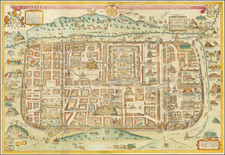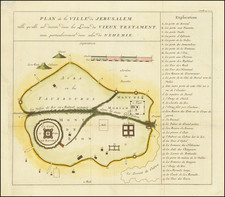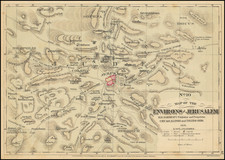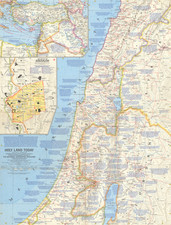Rare early plan / birdseye of Jerusalem, engraved by Romeyne de Hooghe, the highly respected Dutch engraver.
The 17th-century uncolored birdseye view of Jerusalem by De Hooghe presents an intricate and historically insightful perspective of the city. The view captures not only the architectural and urban layout of Jerusalem but also the surrounding hills, including Calvary, Golgata, Kidron, Gihon Mons, and Emaus. This representation intertwines the spiritual and historical significance of the city, emphasizing the locations that have shaped its identity. Below is a summary of at least the most important 20 places, translated and with some historical context:
- Calvary (Golgotha): The site of Jesus Christ's crucifixion.
- Kidron Valley: An ancient valley on the eastern side of Jerusalem.
- Gihon Mons: Possibly referring to the Gihon Spring, an important water source.
- Emaus: Often identified with the biblical Emmaus.
- De Koninglyke Straat: "The Royal Street," possibly a main thoroughfare.
- Priesterstraat: "Priest's Street," possibly an area associated with religious activities.
- Rystraat van Rehabea: "Rehabea's Riding Street," indicating an important road or path.
- Slagthuyzen: Possibly referring to slaughterhouses or butcheries.
- Bissethuys: Might refer to a specific house or building.
- Hof der Buitenlandse Levieten: "Court of the Foreign Levites," a place associated with religious practices.
- Rooms Wagt Huys: "Roman Guard House," indicating Roman influence.
- Vismarkt: The Fish Market, a central trading location.
- Amphitheatre van Pompejus: Referring to an amphitheater built by Pompey.
- Ruyterwagten der Syriers: "Syrian Cavalry Guards," pointing to military or defense structures.
- Koninglyke Graven: "Royal Tombs," burial sites of significance.
- Moloch's Tempel: A temple dedicated to the deity Moloch.
- Graf Christi: "Tomb of Christ," a significant Christian site.
- Toorn Zephina: Perhaps a tower or specific location.
- Hiskia Brug en Graf: Referring to Hezekiah's Bridge and Tomb.
- Slot Antiochi: "Castle of Antioch," a stronghold or fortified structure.
- Crypta Chaldaim: Possibly a crypt or burial place connected to the Chaldeans.
- Schapen Dyk: "Sheep Dike," likely related to livestock or agriculture.
- Dal Benhimmon: Possibly the Valley of Ben Hinnom, a significant biblical location.
- Jezaice Graf: "Isaiah's Tomb," linked to the prophet Isaiah.
- Rode Toorn: "Red Tower," possibly a defensive structure.
- Dal Toorn: "Valley Tower," indicating a tower in a valley.
- Schapen Toorn: "Sheep Tower," perhaps related to pastoral activities.
- Mist Toorn: "Mist Tower," significance is unclear.
- Azzaria: Possibly an area or specific building.
- Eliazel: Possibly a personal or place name.
- Tuyghuys: "Prison House," likely connected to law enforcement or governance.
- Koningin Helenas Hof: "Queen Helena's Court," a royal residence or palace.
- Berenices Hof: "Berenice's Court," possibly a royal or noble residence.
- Slangen Zee: "Sea of Snakes," possibly metaphorical.
- Gabbatha: A stone pavement where Pontius Pilate judged Jesus.
- Rigthuys: "Court House," likely a place for legal matters.
- Fondament Poort: "Foundation Gate," possibly an essential entrance to the city.
- Hananiel Toorn: "Tower of Hananiel," possibly connected to a biblical figure or location.
- Ophel Toorn: "Ophel Tower," an ancient mound in Jerusalem.
- David's Poort: David's Gate, possibly an entrance named after King David.
- Ephraims Poort: Ephraim's Gate, likely an entrance to the city.
- Opper Priester Poort: "High Priest's Gate," possibly an entrance connected to religious leadership.
- Bissethuys: Possibly a specific type of house or building.
- Hof der Buitenlandse Levieten: "Courtyard of the Foreign Levites," likely a religious location.
- Rooms Wagt Huys: "Roman Watch House," reflecting Roman influence.
- Vismarkt: The Fish Market, likely a vital commercial area.
- Amphitheatre van Pompejus: A structure showcasing Roman architectural influence.
- Ruyterwagten der Syriers: "Syrian Cavalry Watch," related to military defense.
- Koninglyke Graven: "Royal Graves," possibly a significant burial site.
- Moloch's Tempel: A temple dedicated to Moloch, indicating diverse religious practices.
- Overbron: Meaning unclear, possibly a location name or specific feature.
- Graf Christi: The Tomb of Christ, a highly significant Christian site.
- Toorn Zephina: Possibly a tower or landmark with unclear significance.
- Hiskia Brug en Graf: Hezekiah's Bridge and Tomb, historically significant.
- Slot Antiochi: Castle of Antioch, possibly a stronghold or fortress.
- Crypta Chaldaim: Likely a crypt or burial place associated with the Chaldeans.
- Schapen Dyk: Sheep Dike, possibly related to agriculture or livestock.
- Dal Benhimmon: Possibly referring to the Valley of Ben Hinnom, significant in biblical history.
- Jezaice Graf: Isaiah's Tomb, linked to the prophet Isaiah.
- Rode Toorn: The Red Tower, likely a defensive structure or landmark.
These places evoke a tapestry of cultural, religious, and historical aspects of Jerusalem, capturing its multifaceted identity during the 17th century. De Hooghe's view serves as both an artistic endeavor and a historical document, linking the past with the present, and inviting a deeper understanding of the city that holds an unparalleled position in human history.












![[ Jerusalem ] Ierusalem](https://storage.googleapis.com/raremaps/img/small/88440.jpg)

![[ Jerusalem ] Vera Hierosolymae Veteris Imago a Ioanne Baptista Villapando . . .](https://storage.googleapis.com/raremaps/img/small/84065.jpg)